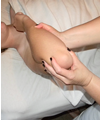Pronator Teres Syndrome and Massage Therapy
Pronator teres syndrome occurs when the pronator teres muscle, which is located deep in the forearm, begins to compress or entrap the median nerve at the elbow.

People with this syndrome experience pain, numbness, and muscle weakness in the forearm and hand. These symptoms are also similar to carpal tunnel syndrome, as it compresses the median nerve at the wrist.
The pronator teres muscle's job is to "pronate" or turn the arm
with the palm side down. There is often a "pulling" sensation, that the
muscle is being pulled beyond what is physically comfortable, when this
syndrome first appears. It is an early sign that the muscle is too
tight.
Specific stretches and exercises are sometimes helpful, but, if not done properly, may worsen the situation.
Most often, the symptoms are on one side, but may affect both sides of the arm at the same time. Continued use, without treatment, will gradually make the pain and weakness worse.
What is the cause of this syndrome?
There are several things that can cause this syndrome:
- Blunt trauma to the muscle
- Repetitive overuse
- Sports injuries
How can massage help?
Specific massage therapy techniques for never mobilization are applied to the muscle, and can stop it from compressing the median nerve.
Some therapists may use Trigger Point Therapy to work out specific trigger points in the pronator teres muscle. The practitioner may also use Myofascial Release techniques or massage therapy techniques for nerve entrapment to encourage release of the muscles.
Certain other stretching exercises could also be suggested by the therapist, as well as a few follow-up visits.
What else can be done to help it heal?
Outside of just massage therapy, the standard R.I.T.E., Rest, Ice, Therapy (such as massage, stretching or exercise) and Elevation, may be the most prescribed treatment for Pronator Teres Syndrome.
Steroids may also be prescribed by a doctor, and surgical decompression may be considered as a last resort.
This DVD, Nerve Mobilization
teaches massage therapy techniques for clients with elbow pain, as well
as many other medical nerve conditions. It discusses safety precautions
and treatment goals for all different types of nerve impingements, and
helps you understand this specific syndrome better.
This is a video clip of this DVD:
It will quickly teach you stretches, how to give a massage to those with the syndrome, and other nerve mobilization techniques for common nerve impingement pain syndromes.
Although massage therapy and nerve mobilization techniques may not be the first choice of care for Pronator Teres Syndrome, it is often a very beneficial treatment, and much preferred by many to surgery and months of physical therapy.
Go back to Massage Education Guide Homepage
Go Back to Pain Syndromes from Pronator Teres Syndrome
New! Comments
Have your say about what you just read! Leave me a comment in the box below.